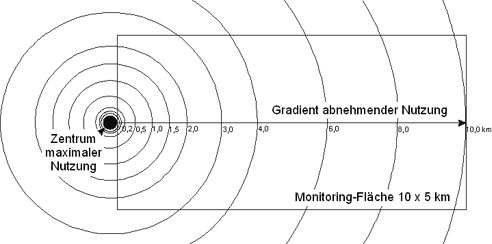
 OBJECTIVES
OBJECTIVES
Range Ecology: Methods
(Dr. Anja Linstaedter)
For an assessment of pasture quality, ecological data have to be collected on spot. Range ecology has developed elaborate sets of methods for pasture assessment, such as monitoring approaches. This implies a field work of several months each year. In our study, the monitoring sites are arranged along gradients of land use intensity. Plots are concentrated close to the centre of maximum use (Fig. 1). Thus the first steep part of the land use gradient (close to a water point or settlement) is particularly well-documented.
|
The environmental conditions on each permanent plot are documented with the
same set of methods. Microhabitats on the 0.1 ha plots are mapped, and
a soil profile is recorded. A rain gauge with daily readings is placed
close to each exlclosure. Fixed-point photographs of the permanent plots
are done on a yearly base.
For better statistical analyses, we concentrate on numerical data. In the tree layer, the population structure and the damage of permantent tree species (such as Colophospermum mopane) are main objective. The grass layer is the most important fodder source for domestic livestock (cattle) and grazer species. Here we study the production of palatable biomass and the ecological state of the pastures (such as perennial grass vitality, see Fig. 2). Perennial grasses are sensitive indicators for land use. The percentage ground cover of all species is recorded annually at the end of the rainy season on nested subplots. Small-scale disturbances are recorded on the same subplots. This allows to connect disturbances with the establishment of perennial species (grasses and tress).
Univariate and multivariate
statistical analyses help to elucidate the impact of environmental
and anthropogenic factors on vegetation structure and composition.
Due to the study design, the gradients of land use intensity structure
are reflected by response variables such as biomass production and
species diversity.
